Washington State University
Mount Vernon Northwestern Research and Extension Center
Mount Vernon, WA 98273-4768
Tuber flea beetle (TFB), Epitrix tuberis Genter lab bioassays.
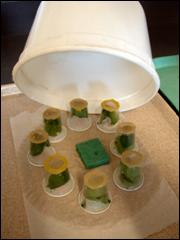 This bioassay was conducted at the Washington State Northwestern Research and Extension Center to evaluate efficacies of two new mode of action chemistries; BAS 320 I (metaflumizone) and DuPont’s DPX-E2Y45 1.67 SC (chlorantraniliprole) compared with newly registered Leverage™ (imidacloprid + cyfluthrin) and Valent’s neonicotinoid Belay™ (clothianidin 2.13 SC). Valent plans to promote a single 2.13 SC formulation of Belay for foliar and in-furrow at planting in potato. Residual leaf dip bioassays were conducted using the terminal leaflet of ‘CalWhite’. Leaflets were dipped in respective de-ionized water-insecticide solutions for approximately 5 sec and air-dried. Five adult TFB were aspirated from our field collected sample and sharply tapped from our 9 dram clear styrene tubes into each bioassay unit with a camel hairbrush. The upper surface of each leaflet was quickly sandwiched between the 4 cm diameter plastic cap and the top opening of a 1 fl oz clear plastic condiment cup. Ventilation holes were opened near the inverted bottom of the cup with the tip of a hot dissecting probe. Each treatment of 9 units was placed in separate ventilated salad crisper units to maintain ambient relative humidity for both the beetles and to maintain the integrity of the leaves. Despite careful attempts to maintain leaf quality throughout the experiment, potato leaf disc began deteriorating after five days. Each treatment was replicated 9× for the two treatments initiated on 13 August (Table 1) and 27 August (Table 2) and observed through 5 DAT.
This bioassay was conducted at the Washington State Northwestern Research and Extension Center to evaluate efficacies of two new mode of action chemistries; BAS 320 I (metaflumizone) and DuPont’s DPX-E2Y45 1.67 SC (chlorantraniliprole) compared with newly registered Leverage™ (imidacloprid + cyfluthrin) and Valent’s neonicotinoid Belay™ (clothianidin 2.13 SC). Valent plans to promote a single 2.13 SC formulation of Belay for foliar and in-furrow at planting in potato. Residual leaf dip bioassays were conducted using the terminal leaflet of ‘CalWhite’. Leaflets were dipped in respective de-ionized water-insecticide solutions for approximately 5 sec and air-dried. Five adult TFB were aspirated from our field collected sample and sharply tapped from our 9 dram clear styrene tubes into each bioassay unit with a camel hairbrush. The upper surface of each leaflet was quickly sandwiched between the 4 cm diameter plastic cap and the top opening of a 1 fl oz clear plastic condiment cup. Ventilation holes were opened near the inverted bottom of the cup with the tip of a hot dissecting probe. Each treatment of 9 units was placed in separate ventilated salad crisper units to maintain ambient relative humidity for both the beetles and to maintain the integrity of the leaves. Despite careful attempts to maintain leaf quality throughout the experiment, potato leaf disc began deteriorating after five days. Each treatment was replicated 9× for the two treatments initiated on 13 August (Table 1) and 27 August (Table 2) and observed through 5 DAT.
Leverage and high rate of Belay showed significant though modest mortality of TFB adults at 2 DAT (Table 1). By 5 DAT, all beetles were dead in the two Belay treatments while Leverage and two rates of BAS 320 I provided mortality at about 88%. Again, our inexperience with metaflumizone failed to score individuals exhibiting immobility and cessation of feeding as ‘non-pests’ or simply dead, in this case between 2-5 DAT. BASF notes insect death is ultimately ‘delayed’ from 1-72 hours after ingestion. We observed these same symptoms for several small fruit root weevils (i.e.,Otiorhynchus spp.) exposed to BAS 320 I. In test 1, results for three rates of DPX-E2Y45 were disappointing compared with its performance under similar conditions.
By 1 DAT, both rates of Belay and Leverage provided significant control of TFB (Table 2) given the experimental design used for the bioassay. By 3 DAT both rates of BAS 320 I showed comparable adult mortality with Belay. By this time, cessation of feeding was evident with the ingestion of BAS 320 I and evidence of immobility of many of the adults, which we did not score as dead for these to lab bioassays. In this second test, the 3 rates of DPX-E2Y45 provided comparable mortality with each other though significantly lower than BAS 320 I and the neonicotinoid Belay and higher than the unusually high mortality for the untreated check. The issue with check mortality was noted in 2007 and resulted in the development of clip cages designed to hold adult flea beetle on potato plant foliage.
| Treatment | Rate/acre | Percent Mortality | |
|---|---|---|---|
| 2 DAT | 5 DAT | ||
| Mean within columns followed by the same letter are not significantly different (Fisher’s protected LSD, P<0.05), PRC ANOVA SAS. | |||
| PP = Penetrator Plus. | |||
| BAS 320 I + PP | 11.4 fl oz | 14.8cd | 88.4a |
| BAS 320 I + PP | 16.0 fl oz | 23.5cd | 87.2a |
| Belay 2.13SC | 1.8 fl oz | 41.2bc | 100.0a |
| Belay 2.13SC | 2.8 fl oz | 60.1ab | 100.0a |
| DPX-E2Y45 1.67SC | 3 fl oz | 28.1cd | 38.3b |
| DPX-E2Y45 1.67SC | 5 fl oz | 28.7cd | 31.0bc |
| DPX-E2Y45 1.67SC | 7 fl oz | 22.2cd | 31.1bc |
| Leverage 2.7SE | 3.75 fl oz | 77.9a | 88.9a |
| Untreated check | 13.7d | 12.3c | |
| Treatment | Rate/acre | Percent Mortality | ||
|---|---|---|---|---|
| 1 DAT | 3 DAT | 5 DAT | ||
| Mean within columns followed by the same letter are not significantly different (Fisher’s protected LSD, P<0.05), PRC ANOVA SAS. | ||||
| PP = Penetrator Plus. | ||||
| BAS 320 I + PP | 11.4 fl oz | 47.8b | 88.3ab | 95.6ab |
| BAS 320 I + PP | 16.0 fl oz | 47.8b | 90.6ab | 100.0a |
| Belay 2.13SC | 1.8 fl oz | 93.3a | 97.8a | 100.0a |
| Belay 2.13SC | 2.8 fl oz | 87.0a | 97.8a | 100.0a |
| DPX-E2Y45 1.67SC | 3 fl oz | 39.3b | 61.1c | 77.8bc |
| DPX-E2Y45 1.67SC | 5 fl oz | 25.2b | 56.7c | 69.4c |
| DPX-E2Y45 1.67SC | 7 fl oz | 44.4b | 65.2bc | 78.5bc |
| Leverage 2.7SE | 3.75 fl oz | 100.0a | ||
| Untreated check | 0 | 25.6d | 43.5d | |
Greenhouse bioassays.
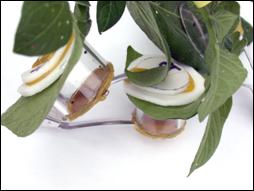 These leaf dip bioassays were conducted in a controlled environmental greenhouse at the WSU NWREC using leaves of ‘CalWhite’ potato plants transplanted from the field into 3-gallon pots. Leaflets were dipped into respective de-ionized water-insecticide solutions for 5 sec and air-dried. Five to seven field collected TFB adults were aspirated and transferred from 9 dram clear plastic vials into clip cages. These clip cages were fabricated from 4 inch long hair clips made of a 1.5 inch diameter by 1 inch tall, clear tubing covered with small mesh plastic screen glued to the top of the cylinder. This unit was glued to the underside of the top arm of the clip while the top of the bottom arm was glued to a circular foam disk larger in diameter than the cylinder which when placed beneath the bottom of a potato leaf provided an escape proof floor for the TFB bioassay clip cell. This clip cage provided a more natural environment and observational arena for the TFB while observing residual activity for the various systemic and contact/ingestion action insecticides tested for TFB mortality.
These leaf dip bioassays were conducted in a controlled environmental greenhouse at the WSU NWREC using leaves of ‘CalWhite’ potato plants transplanted from the field into 3-gallon pots. Leaflets were dipped into respective de-ionized water-insecticide solutions for 5 sec and air-dried. Five to seven field collected TFB adults were aspirated and transferred from 9 dram clear plastic vials into clip cages. These clip cages were fabricated from 4 inch long hair clips made of a 1.5 inch diameter by 1 inch tall, clear tubing covered with small mesh plastic screen glued to the top of the cylinder. This unit was glued to the underside of the top arm of the clip while the top of the bottom arm was glued to a circular foam disk larger in diameter than the cylinder which when placed beneath the bottom of a potato leaf provided an escape proof floor for the TFB bioassay clip cell. This clip cage provided a more natural environment and observational arena for the TFB while observing residual activity for the various systemic and contact/ingestion action insecticides tested for TFB mortality.
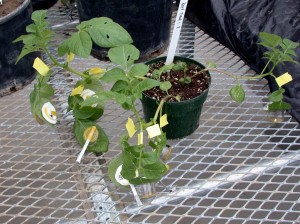 Test 1 (Table 3) was initiated on 3 September and Test 2 on 19 September. Compared with the untreated check, all of the insecticides including the biopesticideMetarhizium anisopliae were significantly different after 1 and 2 DAT. Mortality for BAS 320 I and DPX-E2Y45 increased by 5- and 3-fold, respectively, at 2 DAT when trialed with the clip cages (Table 1, Table 3, Table 4). Enhanced mortality of 1.9-fold was measured for Belay while the pyrethroid/neonicotinoid provided quick knockdown with either the clip cages of isolations cells (Table 1, Table 3, Table 4). From these tests, all of the insecticides tested and manufacturer’s recommended rates, provided excellent efficacy for their foliar application for adult TFB control. The registration of BAS 320 I and DPX-E2Y45 will provide two new mode of action chemistries that will fit will with our current resistance management program that included rules for rotating chemical classes of insecticides in our current vast arsenal of potato insecticides.
Test 1 (Table 3) was initiated on 3 September and Test 2 on 19 September. Compared with the untreated check, all of the insecticides including the biopesticideMetarhizium anisopliae were significantly different after 1 and 2 DAT. Mortality for BAS 320 I and DPX-E2Y45 increased by 5- and 3-fold, respectively, at 2 DAT when trialed with the clip cages (Table 1, Table 3, Table 4). Enhanced mortality of 1.9-fold was measured for Belay while the pyrethroid/neonicotinoid provided quick knockdown with either the clip cages of isolations cells (Table 1, Table 3, Table 4). From these tests, all of the insecticides tested and manufacturer’s recommended rates, provided excellent efficacy for their foliar application for adult TFB control. The registration of BAS 320 I and DPX-E2Y45 will provide two new mode of action chemistries that will fit will with our current resistance management program that included rules for rotating chemical classes of insecticides in our current vast arsenal of potato insecticides.
| Treatment | Rate/acre | Percent Mortality | ||
|---|---|---|---|---|
| 1 DAT | 2 DAT | 3 DAT | ||
| Mean within columns followed by the same letter are not significantly different (Fisher’s protected LSD, P<0.05), PRC ANOVA SAS. | ||||
| DPX-E2Y45 1.67SC | 3 fl oz | 100a | ||
| DPX-E2Y45 1.67SC | 5 fl oz | 100a | ||
| DPX-E2Y45 1.67SC | 7 fl oz | 100a | ||
| Belay 2.13SC | 1.8 fl oz | 97a | 100a | |
| Belay 2.13SC | 2.8 fl oz | 93a | 100a | |
| Leverage 2.7SE | 3.75 fl oz | 96a | 88a | 100a |
| Metarhizium anisopliae | 1.25 ml/L | 80a | ||
| Metarhizium anisopliae | 2.5 ml/L | 80a | 86a | 100a |
| Untreated check | 0 | 3b | 3b | |
| Treatment | Rate/acre | Percent Mortality | |
|---|---|---|---|
| 2 DAT | 2 DAT | ||
| Mean within columns followed by the same letter are not significantly different (Fisher’s protected LSD, P<0.05), PRC ANOVA SAS. | |||
| PP = Penetrator Plus. | |||
| BAS 320 I + PP | 11.4 fl oz | 98a | 100a |
| BAS 320 I + PP | 16.0 fl oz | 100a | |
| Belay 2.13SC | 1.8 fl oz | 98a | 100a |
| Belay 2.13SC | 2.8 fl oz | 100a | |
| DPX-E2Y45 1.67SC | 3 fl oz | 100a | |
| DPX-E2Y45 1.67SC | 5 fl oz | 100a | |
| DPX-E2Y45 1.67SC | 7 fl oz | 64b | 100a |
| Leverage 2.7SE | 3.75 fl oz | 100a | |
| Untreated check | 14c | ||
Mycoinsecticides
Beauveria bassiana
NWREC greenhouse propagated ‘Red Chieftain’ in 8″ pots were used for the mycoinsecticide bioassays. Terminal leaflets of two from two plants were dipped into either high (.35g/5fl oz) or low rates (.175g/5fl oz) of Botanigard® 22 WP (Beauveria bassiana strain GHA, 2 x 1011 conidia per gram AI), (BioWorks, Inc., Victor, NY) and allowed to air-dry. The number of clip cages/plant varied according to the number of leaves/plant, which could support the size and weight of the clip cage. Numbers of tuber flea beetles/clip cage also varied due to the high mobility of the flea beetles and difficulty of placing them into the clip cages.
After 5 days, caged TFB were scored as dead or alive. Dead beetles were not removed until the end of the test due to the risk of escape by the remaining live beetles. At 10 DAT beetles were not significantly affected by the entomopathogenic fungi at either the low or high rates, evident from the low number of dead beetles.
The poor efficacy of the B. bassiana experiment agrees with that of the 2007 bioassay results. BotaniGard® 22 WP is recommended for a management program, aimed at keeping pest populations below damaging levels rather pest elimination. Infected insects typically take 3-7 days to die and pest populations don’t decline until 7-10 days following the first spray. A management approach, combined with inability to control TFB, suggests that B. bassiana may reduce but not eliminate the more damaging second generation, therefore making it a less desirable choice for controlling TFB in a field setting. The experimental design is problematic because dead beetles could not be examined for fungal development prior to the end of the test, at which time the cadavers were completely dry.
Metarhizium anisopliae
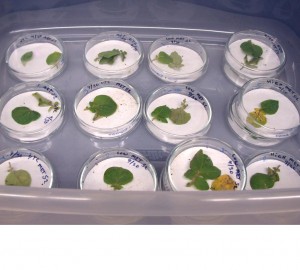 Potato leaves from NWREC greenhouse grown ‘Red Chieftain’ in 8″ pots, were excised and placed on damp cotton in Petri dishes. Ten tuber flea beetles were inserted into each Petri dish. A liquid formulation of Metarhizium anisopliae strain 52(Novozymes Biologicals, Inc., NZBPC2102, Salem, VA) was mixed at high (29 fl oz/ac) and low (15 fl oz/ac) rates. The untreated check consisted of a similar setup.
Potato leaves from NWREC greenhouse grown ‘Red Chieftain’ in 8″ pots, were excised and placed on damp cotton in Petri dishes. Ten tuber flea beetles were inserted into each Petri dish. A liquid formulation of Metarhizium anisopliae strain 52(Novozymes Biologicals, Inc., NZBPC2102, Salem, VA) was mixed at high (29 fl oz/ac) and low (15 fl oz/ac) rates. The untreated check consisted of a similar setup. 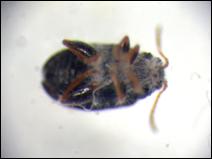 There were 15 total Petri dishes for the bioassay. Petri dishes with the beetles were treated inside a cage to prevent escape. Leaves with beetles were misted until wet but not dripping. Five days following treatment, the beetles exhibited a dose related response with average mortalities of 21%, 13% and 4% (high, low and UTC respectively).
There were 15 total Petri dishes for the bioassay. Petri dishes with the beetles were treated inside a cage to prevent escape. Leaves with beetles were misted until wet but not dripping. Five days following treatment, the beetles exhibited a dose related response with average mortalities of 21%, 13% and 4% (high, low and UTC respectively).
Azadirachtin seed treatment
Potato seeds were treated with the recommended field rate of azadirachtin (AZA-Direct, Gown, Yuma, AZ) and planted in 4-inch pots, in the greenhouse. The trial consisted of two sleeve cages (Bugdorm™, Taiwan) (24″ × 24″ × 24″) each containing 4 pots for a total of 8 replicates, maintained in a climate-controlled greenhouse. A sleeve cage with flea beetle infested 4-inch pots served as the control. After the plants reached approximately 3″ tall, aliquots of 25 field collected tuber flea beetles were released into each cage on three separate dates. No significant feeding damage or subsequent generation of TFB were observed in the cages, except the control.
Entomopathogenic nematodes
Three cages, each containing four greenhouse potato plants, were infested at the rate of 100 tuber flea beetles/cage. After two weeks the potato plants and TFB were mechanically removed, leaving only the pots with soil and tubers. Pots were separated into individual cages and arranged randomly in the greenhouse. Prepackaged nematodes containing infective juveniles in a moist, inert carrier from Becker Underwood Inc., Ames, IA, were mixed according to label rates and each pot was drenched with the recommended dose. Four pots were drenched with Steinernema feltiae (Filipjev) (Nemasys®), four with Steinernema kraussei (Steiner) (Nemasys® L), and another four were drenched with an equal amount of water and served as the control. Beetles were counted and removed from the cages as they emerged, until no more live beetles were observed. Empirical results indicate S. kraussei was less effective than S. feltiae against the larval tuber flea beetles. This is in agreement with the 2007 test results. Entomopathogenic nematodes S. riobrave Cabanillaset al. (BioVector®), S. carpocapsae (Weiser) (Millenium®) and Heterorhabditis bacteriophora Poinar, were tested for efficacy against tuber flea beetle larvae on 2 October. Unfortunately the low emergence rate following treatment for both the treated and controls, indicated the female beetles collected for the test date were the overwintering generation and oviposition was absent or greatly reduced. The late test date was due to availability issues with the nematodes.